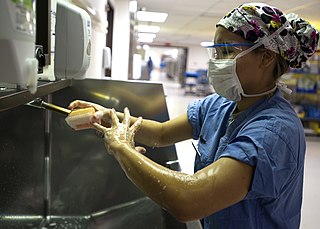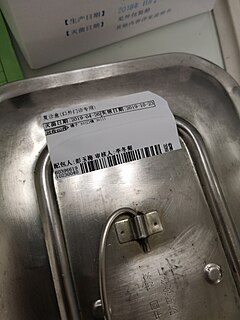
An autoclave is a machine used to carry out industrial and scientific processes requiring elevated temperature and pressure in relation to ambient pressure and/or temperature. Autoclaves are used before surgical procedures to perform sterilization and in the chemical industry to cure coatings and vulcanize rubber and for hydrothermal synthesis. Industrial autoclaves are used in industrial applications, especially in the manufacturing of composites.

Sterilization refers to any process that removes, kills, or deactivates all forms of life and other biological agents such as prions present in or on a specific surface, object, or fluid. Sterilization can be achieved through various means, including heat, chemicals, irradiation, high pressure, and filtration. Sterilization is distinct from disinfection, sanitization, and pasteurization, in that those methods reduce rather than eliminate all forms of life and biological agents present. After sterilization, an object is referred to as being sterile or aseptic.

The sterile insect technique (SIT) is a method of biological insect control, whereby overwhelming numbers of sterile insects are released into the wild. The released insects are preferably male, as this is more cost-effective and the females may in some situations cause damage by laying eggs in the crop, or, in the case of mosquitoes, taking blood from humans. The sterile males compete with fertile males to mate with the females. Females that mate with a sterile male produce no offspring, thus reducing the next generation's population. Sterile insects are not self-replicating and, therefore, cannot become established in the environment. Repeated release of sterile males over low population densities can further reduce and in cases of isolation eliminate pest populations, although cost-effective control with dense target populations is subjected to population suppression prior to the release of the sterile males.
Sterilization may refer to:

Asepsis is the state of being free from disease-causing micro-organisms. There are two categories of asepsis: medical and surgical. The modern day notion of asepsis is derived from the older antiseptic techniques, a shift initiated by different individuals in the 19th century who introduced practices such as the sterilizing of surgical tools and the wearing of surgical gloves during operations. The goal of asepsis is to eliminate infection, not to achieve sterility. Ideally, a surgical field is sterile, meaning it is free of all biological contaminants, not just those that can cause disease, putrefaction, or fermentation. Even in an aseptic state, a condition of sterile inflammation may develop. The term often refers to those practices used to promote or induce asepsis in an operative field of surgery or medicine to prevent infection.
A chemosterilant is a chemical compound that causes reproductive sterility in an organism. Chemosterilants are particularly useful in controlling the population of species that are known to cause disease, such as insects, or species that are, in general, economically damaging. The sterility induced by chemosterilants can have temporary or permanent effects. Chemosterilants can be used to target one or both sexes, and it prevents the organism from advancing to be sexually functional. They may be used to control pest populations by sterilizing males. The need for chemosterilants is a direct consequence of the limitations of insecticides. Insecticides are most effective in regions in which there is high vector density in conjunction with endemic transmission, and this may not always be the case. Additionally, the insects themselves will develop a resistance to the insecticide either on the target protein level or through avoidance of the insecticide in what is called a behavioral resistance. If an insect that has been treated with a chemosterilant mates with a fertile insect, no offspring will be produced. The intention is to keep the percent of sterile insects within a population constant, such that with each generation, there will be fewer offspring.

Germ-free organisms are multi-cellular organisms that have no microorganisms living in or on them. Such organisms are raised using various methods to control their exposure to viral, bacterial or parasitic agents. When known microbiota are introduced to a germ-free organism, it usually is referred to as a gnotobiotic organism, however technically speaking, germ-free organisms are also gnotobiotic because the status of their microbial community is known. Due to lacking a microbiome, many germ-free organisms exhibit health deficits such as defects in the immune system and difficulties with energy acquisition. Typically germ-free organisms are used in the study of a microbiome where careful control of outside contaminants is required.

Shelf-stable food is food of a type that can be safely stored at room temperature in a sealed container. This includes foods that would normally be stored refrigerated but which have been processed so that they can be safely stored at room or ambient temperature for a usefully long shelf life.
Cytoplasmic male sterility is total or partial male sterility in plants as the result of specific nuclear and mitochondrial interactions. Male sterility is the failure of plants to produce functional anthers, pollen, or male gametes.
In microbiology, sterility assurance level (SAL) is the probability that a single unit that has been subjected to sterilization nevertheless remains nonsterile.
Barrier isolator is a general term that includes two types of devices: isolators and restricted access barriers (RABS). Both are devices that provide a physical and aerodynamic barrier between the external clean room environment and a work process. The isolator design is the more dependable of the two barrier design choices, as it prevents contamination hazards by achieving a more comprehensive separation of the processing environment from the surrounding facility. Nonetheless, both Isolator and RABS designs are contemporary approaches developed over the last 35 years and a great advancement over designs of the 1950s-70s that were far more prone to microbial contamination problems.
Aseptic processing is a processing technique wherein commercially thermally sterilized liquid products are packaged into previously sterilized containers under sterile conditions to produce shelf-stable products that do not need refrigeration. Aseptic processing has almost completely replaced in-container sterilization of liquid foods, including milk, fruit juices and concentrates, cream, yogurt, salad dressing, liquid egg, and ice cream mix. There has been an increasing popularity for foods that contain small discrete particles, such as cottage cheese, baby foods, tomato products, fruit and vegetables, soups, and rice desserts.
Dry heat sterilization of an object is one of the earliest forms of sterilization practiced. It uses hot air that is either free from water vapor or has very little of it, where this moisture plays a minimal or no role in the process of sterilization.
Moist heat sterilization describes sterilization techniques that use hot water vapor as a sterilizing agent. Heating an article is one of the earliest forms of sterilization practiced. The various procedures used to perform moist heat sterilization process cause destruction of micro-organisms by denaturation of macromolecules.
Inherited sterility in insects is induced by substerilizing doses of ionizing radiation. When partially sterile males mate with wild females, the radiation-induced deleterious effects are inherited by the F1 generation. As a result, egg hatch is reduced and the resulting offspring are both highly sterile and predominately male. Compared with the high radiation required to achieve full sterility in Lepidoptera, the lower dose of radiation used to induce F1 sterility increases the quality and competitiveness of the released insects as measured by improved dispersal after release, increased mating ability, and superior sperm competition.
Sterility is the physiological inability to effect sexual reproduction in a living thing, members of whose kind have been produced sexually. Sterility has a wide range of causes. It may be an inherited trait, as in the mule; or it may be acquired from the environment, for example through physical injury or disease, or by exposure to radiation.
Bacillus pumilus is a Gram-positive, aerobic, spore-forming bacillus commonly found in soil.

The central sterile services department (CSSD), also called sterile processing department (SPD), sterile processing, central supply department (CSD), or central supply, is an integrated place in hospitals and other health care facilities that performs sterilization and other actions on medical devices, equipment and consumables; for subsequent use by health workers in the operating theatre of the hospital and also for other aseptic procedures, e.g. catheterization, wound stitching and bandaging in a medical, surgical, maternity or paediatric ward.
Sterile males are deliberately produced by humans in several species for several unrelated purposes:






